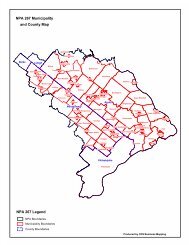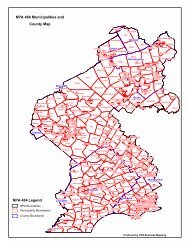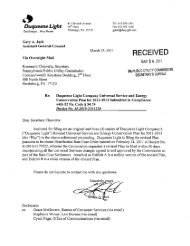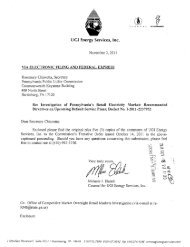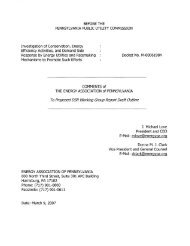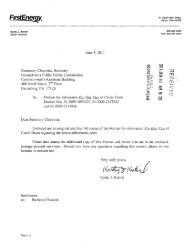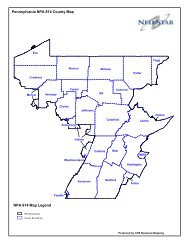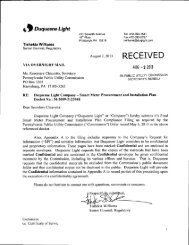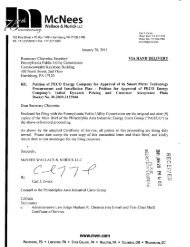2010 Report - Pennsylvania Public Utility Commission
2010 Report - Pennsylvania Public Utility Commission
2010 Report - Pennsylvania Public Utility Commission
Create successful ePaper yourself
Turn your PDF publications into a flip-book with our unique Google optimized e-Paper software.
esults of the EDCs’ efforts will not be known for some time. The recession has already shown itseffect on energy usage; forecasts generally reflect a recovery in <strong>2010</strong>.The EDCs’ residential load growth scenarios typically reflect such variables as weather, personalincome, electricity price (price elasticity), appliance saturation, consumer sentiment, mortgagerates and the number of new residential customers, based on population projections. Commercialsales forecasts relate historical sales to weather, non-manufacturing employment, personal income,real domestic product, the consumer price index and the number of residential customers.Industrial sales are primarily dependent on the level of economic activity within the service areaand in the nation, and reflect specific information concerning large customer plans to expand orclose their facilities. Forecasts of summer and winter peak demands are derived from econometricmodels which utilize the historic relationship of peak demand growth to the growth in the numberof customers, and the effects of weather conditions.PJM performs independent monthly and seasonal forecasts utilizing metered load data, loadmanagement, the PJM Load Forecast Model and Weather Normalization and Peak Allocation. 51After-the-fact hourly load data, provided by the EDCs, is used by PJM for deriving seasonal loadprofiles, weather normalization factors and zonal load contributions. Monthly and seasonal loadforecasts are prepared for each PJM zone, region, the RTO and selected combinations of zones.Weather normalization is employed to adjust historic loads for abnormal weather conditions. Aftereach season, the model results are re-estimated, adding the most recent historical load, weather andeconomic data, to arrive at the weather normalized seasonal peak. Finally, zonal weathernormalizedRTO-coincident summer peak loads are allocated to the wholesale and retail customersin the zones using EDC-specific methodologies that typically employ customer shares of RTOactual peaks.Sectorial and Regional TrendsIn the early 1970s, aggregate sales growth in the residential, commercial and industrial sectorsranged from 6 percent to 8 percent per year and rapidly declined thereafter. Industrial salesinitially peaked in 1979 at 47,636 GWh, dropped to 39,994 GWh in 1982, climbed back to 48,941GWh in 2000 and are currently 88.1 percent of the 2000 level. Over the past 40 years, total saleshave grown an average of 1.8 percent annually: residential at 2.5 percent, commercial at 3.4percent and industrial at 0.5 percent.Statewide residential consumption has increased from 56 GWh per day in 1970 to 138 GWh perday in 2009. Growth in total residential usage has averaged 787 GWh per year. Over the sameperiod, average annual usage per residential customer increased from 6,203 kWh to 10,217 kWh, a65 percent increase. Average usage dropped 3.5 percent from the 2007 high of 10,583 kWh.In 2009, residential usage dropped 1.8 percent, following a decrease of 0.7 percent the previousyear. The five-year aggregate residential forecast shows a growth of 470 GWh per year or anaverage annual growth of 0.9 percent. See Figure 13.51 PJM Manual 19: Load Forecasting and Analysis, Oct. 1, 2009.Electric Power Outlook for <strong>Pennsylvania</strong> 2009-2014 25



